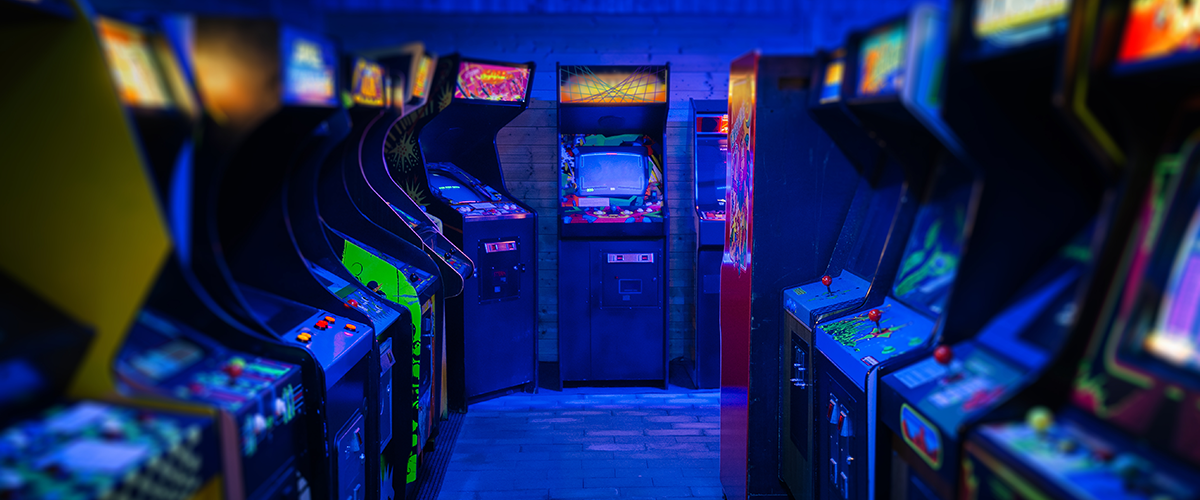
The late 1970s to mid-1980s presented a massive growth for arcade video games across the world, more and more people were spending money at arcades to play hit titles like Space Invaders and Pac-Man. This time period is known as the golden age of arcade video games, and it proved to be a big steppingstone into popular culture entertainment. Check out the list below to see some of the big titles from the golden age that helped shape the arcade industry into what we know today.
Space Invaders (1978)
Space Invaders was the first fixed shooter title in arcades and set the framework for the shoot ‘em up genre of games that we see today. The game has a simple goal of defeating waves of descending aliens with a laser that moves horizontally across the bottom of the screen. This idea hooked players and was an immediate commercial success that grossed $3.8 billion by 1982. Being the best-selling video game at the time, Space Invaders kicked off the golden age of arcade video games and is considered one of the most influential video games of all time.
Designed by: Tomohiro Nishikado
Developed by: Taito
Asteroids (1979)
Following in the footsteps of Space Invaders, Asteroids is a multidirectional shooter arcade game set in space. Players get to control a spaceship where the goal is to destroy the asteroids and flying saucers in your way to try and stay alive. Taking gameplay elements from titles like Computer Space and Space Invaders; Asteroids was a major hit and went on to sell over 70,000 arcade cabinets. By 1980, the game was ported to Atari’s home system due to its popularity.
Designed by: Lyle Rains & Ed Logg
Developed by: Atari
Pac-Man (1980)
Pac-Man took the world by storm in 1980 as a maze action video game developed by Namco. Players simply attempt to eat all of the dots within the maze while avoiding the ghosts scattered around the screen. With a goal of appealing to younger players, Pac-Man focused on making the in-game characters cute and colorful, and that attributed to its widespread commercial success. Today, the game remains one of the best-selling games of all time and is considered a commercial and cultural legacy.
Designed by: Toru Iwatani
Developed by: Namco
Donkey Kong (1981)
In an attempt to create a title that rivals Pac-Man, Nintendo developed the platform game known as Donkey Kong in 1981, featuring the first ever debut of the iconic Mario character. Players control Mario as he climbs ladders and runs and jumps on platforms to rescue Pauline from Donkey Kong at the top. This was the first game that included cutscenes to advance the game’s plot, as well as using graphics to give characters more substance. Throughout the years, characters like Donkey Kong and Mario have pioneered the platform game and continue to be a massive success all around the world.
Designed by: Shigeru Miyamoto & Gunpei Yokoi
Developed by: Nintendo
Defender (1981)
Defender became one of the most important titles in the golden age of arcade video games. As a scrolling shooter video game, players must defeat waves of aliens while protecting astronauts simultaneously. Defender sold over 55,000 units and received high praise among critics for its audio-visuals and overall gameplay. Taking inspiration from previous titles like Space Invaders and Asteroids, it’s no surprise that Defender went on to become one of the highest-grossing arcade games ever.
Designed by: Eugene Jarvis & Larry DeMar
Developed by: Williams Electronics
Q*bert (1982)
Developed by Gottlieb in 1982, Q*bert is a 2D action game with puzzle elements that uses isometric graphics to create a 3D effect on screen. Players attempt to change every cube in the pyramid to a certain color by making Q*bert jump on the cubes while avoiding obstacles and enemies. The original concept of Q*bert was well received by players and critics and went on to be Gottlieb’s most successful video game to date. Not to mention, Q*bert has become one of the most recognized brands from the golden age of arcade games and has recently appeared in movies like Wreck-It Ralph and Pixels.
Designed by: Warren Davis & Jeff Lee
Developed by: Gottlieb

Comment (1)
[…] we have the expertise and equipment to meet your needs. Our extensive range, from re-vamped retro games to cutting-edge new games, is designed to bring people together and keep the spirit of social […]
Comments are closed.